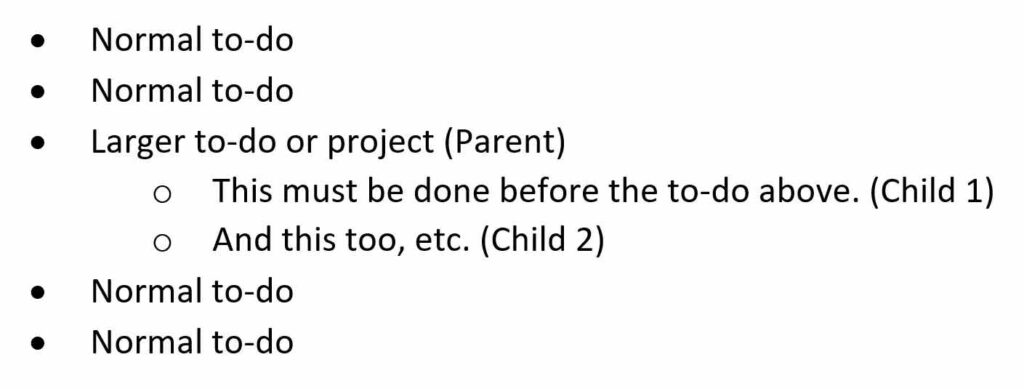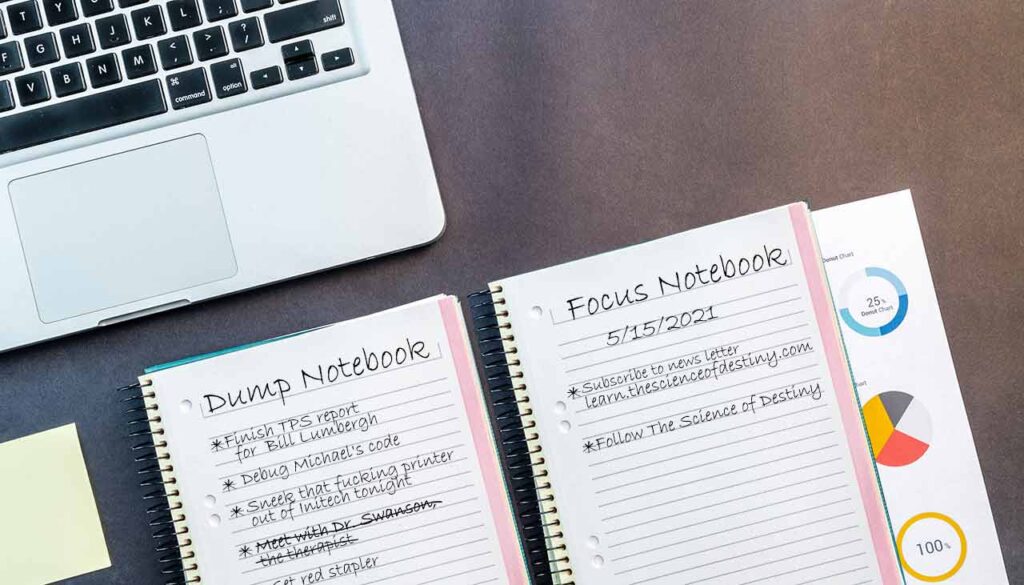The Best To-Do List for Getting Things Done
Have you tried all the productivity apps, methods, and books? Did any of them work for you? Did any of them become part of your life? Me neither.
I have been in Information Technology for over 25 years. It’s normal to have far more to do than there is time. I have tried every productivity-boosting idea or app I could find.
Like you, none of them worked for me. So, I came up with my own. It’s simple, easy to use, and as low tech as it gets.
Let’s get started
All you need are two simple spiral notebooks or the diskbound notebooks I use from Amazon. (FYI, those are Amazon affiliate links).
You may even find the right-size notebooks at your grocery store. Smaller is better. About 8” X 5” is a good size. (Not too small like the pocket-size notebooks).
They need to be small to medium. That way, they don’t take too much of your prime workspace. Full-size 8.5” X 11” notebooks are more likely to be pushed aside. Both notebooks must always remain visible. Preferably right in front of you.
They need to be the spiral-bound type so you can fold the pages on the left to the back cover. The notebooks will be half the size and lay flat. Again, to take up less space.
Two notebooks next to each other, with front covers, folded back, will only be about the size of a sheet of copy paper.
To-do list-venting
The notebook you will keep on the left is your “Dump book.” You write down every to-do that pops into your head or comes your way.
It does not matter if it is something you must do or someone else must but may impact you, write it down.
Use bullets for each task and skip one or two lines between each to-do. There is an example image below.
Writing all your to-dos down will make you feel a lot better. Dumping also frees up parts of your mind and memory — a freer mind and memory get more done with less stress. Add to-dos to your dump list as soon as they come up throughout your day.
The realistic to-do list
The notebook you will keep on the right is your “Focus Notebook.” The Focus notebook is for today’s to-dos only.
Start each morning by writing the date. Then select one or two to-dos from your dump notebook that must get done today.
This is where you say, “Only ONE or two things on my to-do list??? Are you crazy? I have a million things to do every day!” — Chill a minute. Sheesh!
Your Focus notebook is not your itinerary or your entire day’s to-do list. It is only for the one or two critical to-dos you must get done today if humanly possible.
It’s not a bad idea to write down your to-dos for tomorrow at the end of your workday.
Ending your workday with your to-dos set for tomorrow helps your mind switch out of work mode.
That’s it, one or two to-dos for the day! If you find you are killing it every day, add one. But never start the day with more than three to-dos.
It’s a great psychological boost when you finish your to-do list for the day. You can always pick another task from your dump notebook later in the day.
Another reason for the three-max rule; to stop you from torturing yourself with a discouraging, motivation-crushing, depressing, stressful, never-ending to-do list like you always do.
The sub-to-dos you list under the parent are children. Then pick one or two child to-dos and put them in your Focus notebook like normal.
After all the children have been put to bed, cross the parent to-do off if it is finished. If the parent is not finished, move it back to your Focus notebook.
Your dump notebook with a parent/child to-do will look like this:

If you finished yesterday’s to-dos, select one new to-do from your dump list. If you did not complete any of yesterday’s to-dos, go over your dump list and see if they still rank in the #1 or #2 slot for the day.
Then write the #1 or #2 for the day under today’s date in your Focus notebook. You don’t need a new page every day. Just draw a line under where you left off yesterday. Then continue with today’s date followed by today’s to-dos.

Photo by Lukas from Pexels. To-Do list text and 2nd notebook added by Eric Egan. Without Googling it, who does it look like this Dump Notebook belongs to? Or the Movie.
Four great things about your two notebook to-do list system
1. After working all week, do you have anything to show for it? (New files that look like the old files on your desk or inbox don’t count). I don’t know about your job.
But for mine, even after a million keyboard and mouse clicks, my desk looks the same on Friday afternoon as it did Monday morning. Like nothing was accomplished.
After using the two notebooks for a while, you will have something tangible to show for all your hard work. As you cross off to-do after to-do, the pages turn, and the evidence grows.
“Damn, I did get a lot done!” you will silently shout to yourself as you turn page after page of all the crossed-off to-dos you forgot about. It is very gratifying in a thankless world. (I now have a stack of filled notebooks in my office that always make me smile).
2. Less orphaned to-dos. Review the past pages of your dump notebook now and then. See if there is a to-do that is not crossed off. If you find one a few pages back (and you will), cross it off and bring it to the front.
You will be glad your dump notebook reminded you before your boss or client had to.
3. These two notebooks stay at work. You can create two others for home. Leaving your work notebooks at work will help with your work-life balance problem.
If a work to-do pops into your head when you are away from your notebooks, email yourself.
4. Laser focus. You will be surprised how much more you will get done.
I have used the two-notebook to-do method for years. It works for me. I hope it works for you.
The first thing on your new to-do list is to subscribe to my newsletter below.
Also, if you would like to contribute an article to The Science of Destiny, please Contact us.
Thanks for reading.
I hope this helps,
Eric





